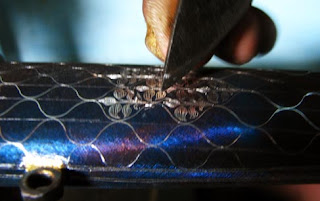The
intricate and timeless art of bone inlay is a tradition that has been handed
down through generations and is practiced in Udaipur, Jodhpur and Jaipur
regions of Rajasthan in India. Handmade and crafted to the highest specifications,
the art of bone inlay has its origins in the royal palaces of Rajasthan where
Maharajas commissioned extravagant inlay furniture pieces such as cabinets,
chests, tables, chairs and even mirrors. This intriguing art is unique to India
and the skilfully handcrafted bone inlay furniture pieces are exported around
the world for their intricate patterns and incredible style.
 |
| Arrangement of bone carvings on timber |
Inlay is the technique of inserting pieces of contrasting material into depressions made on a base object. In bone inlay, the discarded bones of camels passed away due to natural causes are used. So one can enjoy these fine furniture pieces without feeling guilty because no animal is harmed.
The production of bone inlay furniture is a three step process and requires up to a month to create. First the fragments of camel bones are shaped delicately. Then these intricate shapes are affixed onto timber frame in a detailed pattern. After this, resin is filled around the bone shapes to craft the background. The bone pieces are offset by striking colour of the resin to create an exotic looking oriental piece of furniture.
The best part of bone inlay furniture is that they are visually stunning with beautiful and unique patterns and no two pieces are same. These furniture are truly extravagant and so exquisite that one cannot deny the craftsmanship involved.
 |
| White bone inlay console table |
Craftsmen these days are involved in modern styling of bone inlay in keeping with the age old tradition to create a range of stunning furniture that is functional, stylish and long-lasting. Beds, almirahs and console tables crafted with bone inlay are the perfect examples for furniture that are stylish and practical too. These furniture are available in pastel shades and also in subdued lighter colours such as white bone inlay. There are endless possibilities of interesting and beautiful designs on chests, mirrors, tables and frames. Crafted with lot of care and brilliance, these splendid furniture pieces are sure to draw attention and complement a monochromatic space.
 |
| bone inlay bedside table |
Use the bone inlay furniture pieces as attention grabbing accent for your home. The bedside tables and chests crafted with bone inlay add the most exquisite touch to a plain style bedroom. The mirrors are perfect adornment for walls and the bone inlay stools add the finishing touches to any living space. Bone inlay trays are perfect for styling your coffee tables or desks. These also make great gifts for your loved ones.
Become a part of this rich history and bring the opulence of Indian palaces to your home with the signature pieces of bone inlay furniture which will add flair to your home interiors.












